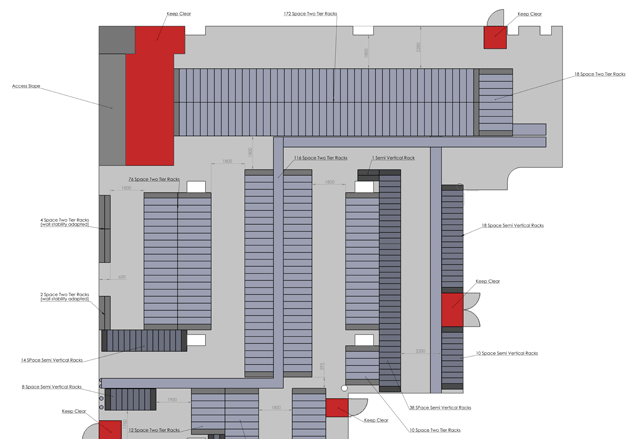As cities grow denser and cycling becomes more popular, the demand for efficient and space-saving bike storage will only increase. Two-tier bicycle racks are a smart solution for locations where floor space is at a premium, yet high-capacity bike parking is needed—think train stations, apartment complexes, schools, and commercial buildings.
These racks are a clever storage system that allows bikes to be parked on two levels—one on the ground and one raised above it using a lifting mechanism. This doubles the capacity of a given footprint compared to single-tier racks and is especially useful in areas where horizontal space is limited. Two-tier bike racks can also be installed in single-sided or double-sided configurations, depending on available space. Our models all feature an even cooler upgrade – the gas strut, a gas-assisted easy lift mechanism which makes users’ lives easier.
In this guide, we’ll break down the essential dimensions you need to consider when planning for a two-tier bike rack setup. Whether you’re designing a new bike shelter or upgrading existing infrastructure, understanding these measurements will help you create a functional and user-friendly layout.
Standard Dimensions for Two-Tier Bicycle Racks
To ensure safe and comfortable use of a two-tier bike rack, you’ll need to account for several key dimensions:
Minimum Requirements:
Height: 2400mm
This height will allow enough space for a bike to be positioned on the upper tier without any issues.
Depth: 1950mm
This is the minimum depth for bike racks; however, for more comfort, we’d always suggest giving it a wider spade.
Entrance space: 1500mm
You will need to allow enough space around the entrance area for users to easily navigate the space and comfortably load and unload their bikes.
Recommended for Comfort:
Depth: 3500mm
To be comfortable, we advise at least a 3500mm depth, which provides space for manoeuvring and lifting bikes safely without worrying that you will hit something.
Width Guidelines
Our width guidelines are based on the number of bikes and, therefore, racks you are installing. Here are the numbers you need to know at a glance.
- 4 bikes – 1125mm
- 6 bikes – 1500mm
- 8 bikes – 1875mm
- 10 bikes – 2250mm
- 12 bikes – 2625mm
- 14 bikes – 3000mm
- 16 bikes – 3375mm
- 18 bikes – 3750mm
- 20 bikes – 4125mm
- Add 375mm for each extra 2 bikes
These widths are calculated to give each bike sufficient space without handlebars clashing or bikes getting tangled.
Space Planning Tips
When planning out a two-tier bike rack storage space, one of the first questions in your head might be how to calculate how many bikes you can fit in the area of your size.
So, we will start here. Calculating how many bikes you can house is easy to work out. All you need to do is measure the length of the area in which you want to fit the rack. The length (mm) divided by 375mm = number of bikes that will fit on the bottom row. Multiply by 2 to get the total number of bike spaces, and subtract 2 bikes to allow for the handlebars to stick out. For example. 4000mm length divided by 375 = 10.666. Multiplied by 2 = 21.333, then you need to round that down to 20 bikes.
As a general tip, we’d say you need to think vertically. These bikes are not like the others. Two-tier bikes are stacked space-savers, but they do run tall. They need adequate ceiling height for smooth operation, and that should be one of your first questions – do you have enough height? If you do, that would is great. You should go ahead and press buy or get in touch to talk about specifics with us. If not, you should look for either an alternative space or a product that fits well with your setup.
The next tip is to remember to leave room for movement. These bike racks are easy to use, but they do require a little bit of manoeuvring to get the bike in the right position. So, stick to that 1500mm entrance clearance—it isn’t just a suggestion. Users need that space to walk in, lift bikes, and turn without bumping into each other and causing unnecessary frustration.
Speaking of entrance space, naturally, it goes without saying if you’re thinking of going for a double-sided layout, double your entrance space as you’d need some on each side where a bike will be loaded and between rows.
Lastly, it’s worth saying that bikes are becoming quite common, and active travel is slowly taking the spotlight as a green alternative to commuting with a car. It’s quicker than getting us all to buy EVs, so we expect to see more of it. This means that in an ideal world, anyone installing bike racks and shelters should think ahead and plan for growth. If you can design the area so more racks can be added later, we are pretty sure this will come in handy in the future.
When it comes to installing a two-tier bicycle rack system, precision matters. From vertical clearance to aisle width and the right amount of space per bike, these measurements ensure both functionality and user comfort. By sticking to the recommended dimensions—especially the 2400mm height and 3500mm depth—you’ll create a bike storage area that’s practical, scalable, and cyclist-friendly. Whether you’re fitting racks for four bikes or forty, a little planning goes a long way.

